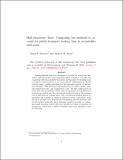Half-(head)way there: Comparing two methods to account for public transport waiting time in accessibility indicators
Author(s)
Stewart, Anson F; Byrd, Andrew M
DownloadHalf_Headway_Paper__EPB_preprint_.pdf (25.50Mb)
Open Access Policy
Open Access Policy
Creative Commons Attribution-Noncommercial-Share Alike
Terms of use
Metadata
Show full item recordAbstract
<jats:p> Various methods have been developed to account for travel time variability and uncertainty when analyzing public transport networks and computing related accessibility indicators. In this paper, we establish some convergence characteristics of one such method, implemented in the R5 routing engine, yielding guidelines for the minimum number of randomized schedules. This parameter has implications for result stability, analysis turnaround time, and computation costs. We also confirm that for travel time and accessibility results, there are spatially varying differences between our method and the conventional method relying on the assumption of half-headway waiting times. The conventional method appears to understate the benefits of transit in certain locations, particularly those served by multiple lines. Researchers and planning practitioners may find the R5 method preferable when analyzing complex networks or comparing transit scenarios where routes are specified in terms of headways or frequencies, rather than complete schedules with exact departure times for each trip. </jats:p>
Date issued
2022-11-30Department
Massachusetts Institute of Technology. Department of Urban Studies and PlanningPublisher
SAGE Publications
Citation
Stewart, Anson F and Byrd, Andrew M. 2022. "Half-(head)way there: Comparing two methods to account for public transport waiting time in accessibility indicators."
Version: Author's final manuscript
ISSN
2399-8083
2399-8091
Keywords
Management, Monitoring, Policy and Law, Nature and Landscape Conservation, Urban Studies, Geography, Planning and Development, Architecture